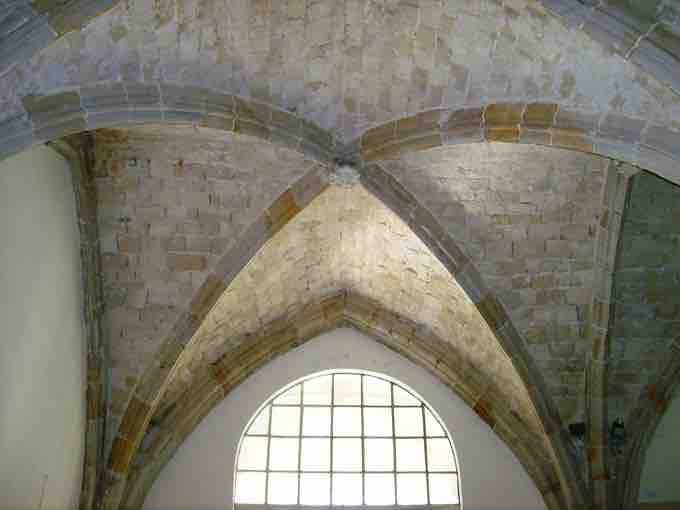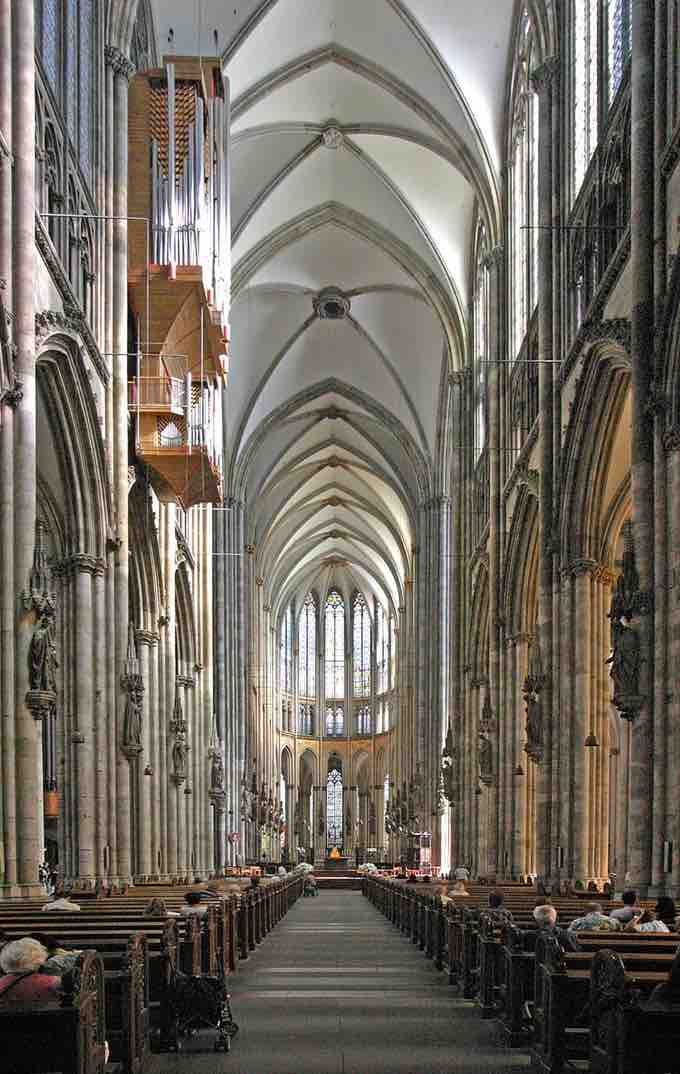The Gothic cathedral represented the universe in microcosm, and each architectural concept, including the height and perfect ratios of the structure, were intended to convey a theological message: the great glory of God and his creation of a perfect universe. The building becomes a microcosm in two ways. First, the mathematical and geometrical nature of the construction is an image of the orderly universe, in which an underlying rationality and logic can be perceived. Second, the statues, sculptural decoration, stained glass, and murals incorporate the essence of creation in depictions of events from the Old and New Testaments.
Most Gothic churches have the Latin cross (or "cruciform") plan, with a long nave making the body of the church. This nave is flanked on either side by aisles, a transverse arm called the transept, and, beyond it, an extension referred to as the choir.
One of the defining characteristics of Gothic architecture is the pointed or ogival arch. Arches of this type were used in the Near East in pre-Islamic as well as Islamic architecture before they were structurally employed in Gothic architecture. They are thought to have been the inspiration for their use in France at the Autun Cathedral, which is otherwise stylistically Romanesque. The way in which the pointed arch was drafted and utilized developed throughout the Gothic period, and four popular styles emerged: the Lancet arch, the Equilateral arch, the Flamboyant arch, and the Depressed arch.

Autun Cathedral, ca. 1120-46
Exterior of Autun Cathedral
The Gothic vault, unlike the semi-circular vault of Roman and Romanesque buildings, can be used to roof rectangular and irregularly shaped plans such as trapezoids. This enabled architects to raise vaults much higher than was possible in Romanesque architecture. While the use of the pointed arch gave a greater flexibility to architectural form, it also gave Gothic architecture a very different and more vertical visual characteristic than Romanesque architecture.
In Gothic architecture the pointed arch is used in every location where a vaulted shape is called for, both structurally and decoratively. Gothic openings such as doorways, windows, arcades, and galleries have pointed arches. Rows of pointed arches upon delicate shafts form a typical wall decoration known as a blind arcade. Niches with pointed arches that contain statuary are a major external feature. The pointed arch lent itself to elaborate intersecting shapes, which developed complex Gothic tracery within window spaces and formed the structural support of the large windows that are characteristic of the style.

Cross-ribbed vault, Bonne-Espérance Abbey, Vellereille-les-Brayeux, Belgium, ca, 13th century
Ogival, or pointed arches, increased in popularity in the Gothic period.
The façade of a large church or cathedral, often referred to as the West Front, is generally designed to create a powerful impression on the approaching worshiper. In the arch of the door (the tympanum) is often a significant sculpture representing scenes from Christian Theology, most frequently Christ in Majesty and Judgment Day. If there is a central door jamb or a tremeau, then it frequently bears a statue of the Madonna and Child.
The West Front of a French cathedral, along with many English, Spanish, and German cathedrals, generally has two towers, which, particularly in France, express an enormous diversity of form and decoration. A characteristic of French Gothic church architecture is its height, both absolute and in proportion to its width, the verticality suggests an aspiration to Heaven. As the Gothic Age progressed in France, the different towns and cities may have been in competition with one another to create the tallest Cathedral. Architects also closely guarded the ratios they used in their architectural plans.

Interior of Cologne Cathedral
The verticality demonstrated in this image is a definitive feature of Gothic architecture.
Another one of the most distinctive characteristics of Gothic architecture is the expansive area of windows and the large size of the many individual windows. The increase in the use of large windows during the Gothic period is directly related to the use of the pointed arch, the ribbed vault, and the flying buttress. All of these architectural features absorbed the weight of the structure, which had rested on the walls in Romanesque architecture. Since the walls had less weight to support, thanks to these innovations, architects were able to pierce the walls of the structures with windows without risking the structural soundness of the cathedral.